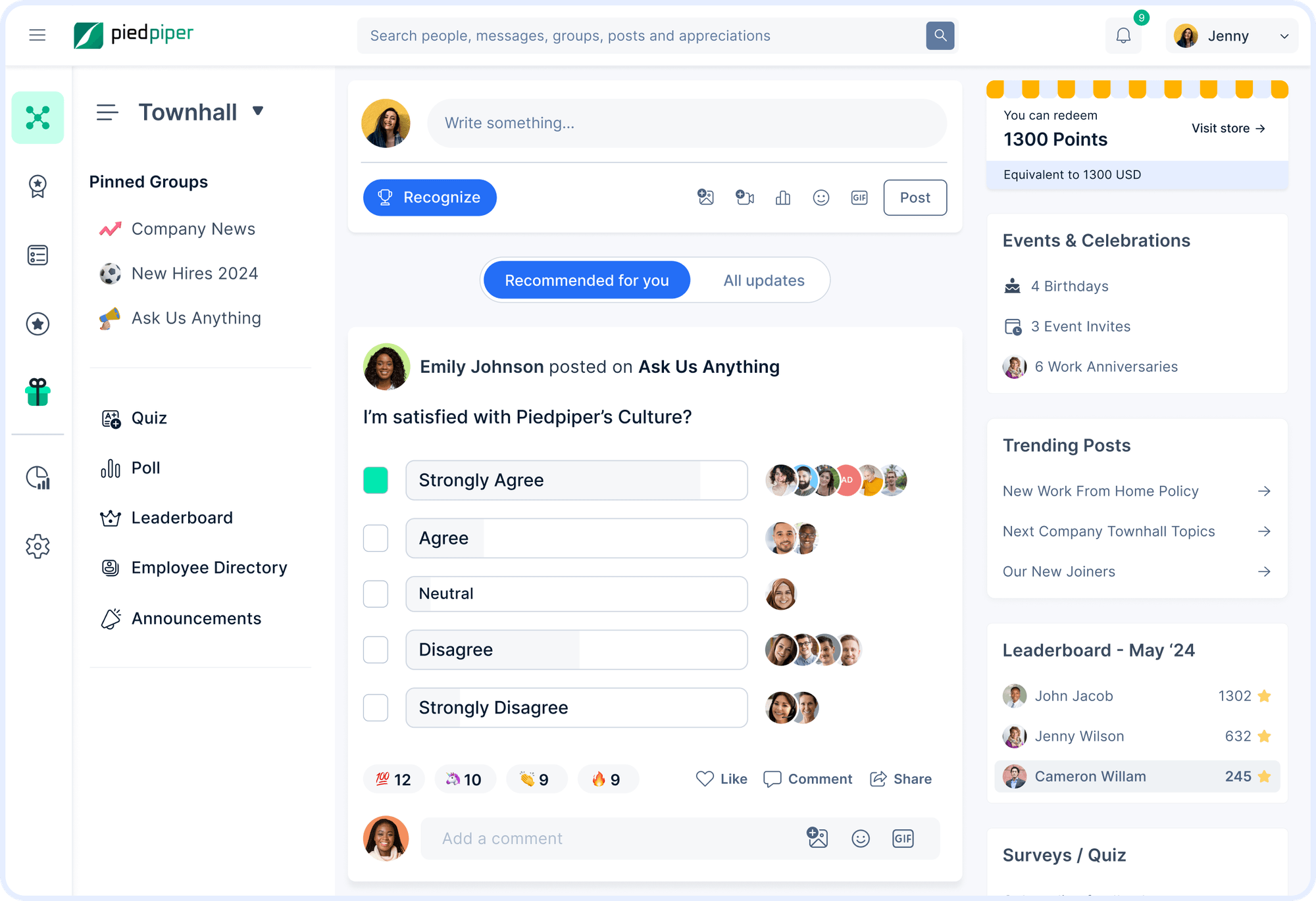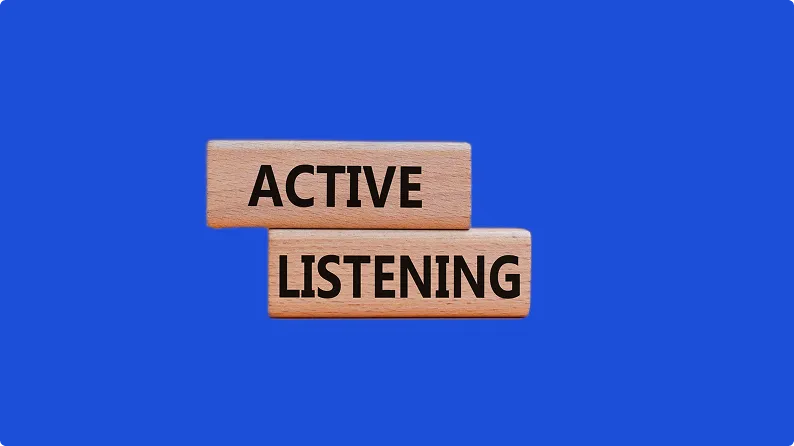On this page
To succeed in today’s workplace, mastering technical skills is only part of the equation. Whether you're a writer perfecting grammar and syntax, an HR professional handling people and processes, or an executive making high-stakes decisions, your growth depends on more than domain expertise alone.
What truly sets successful professionals apart is their ability to connect, understand, and communicate effectively with others. That’s where soft skills—especially active listening—come into play.
Developing active listening in the workplace is essential for building strong relationships, enhancing collaboration, and driving better outcomes across teams. It’s a skill that supports not only everyday conversations but also high-impact interactions like feedback sessions, team check-ins, and decision-making discussions.
But what is active listening and why is it important? It’s the practice of being fully present and engaged during conversations—paying attention to both words and non-verbal cues, and responding with empathy and clarity. This kind of listening creates trust, prevents miscommunication, and helps people feel heard and valued.
The benefits of active listening go far beyond improved communication. It helps you navigate conflict, motivate your team, understand diverse perspectives, and become a more thoughtful, responsive leader.
In this guide, we’ll explore the fundamentals of active listening—what it is, why it matters, and how to strengthen it in your daily work life. Whether you're looking to elevate your leadership skills or simply become a better colleague, these insights will help you become a more impactful communicator.
Let’s dive in!
What is active listening?
This description can be confusing - when you hear what people say, aren’t you listening to them? After all, listening is an activity already.
But here’s an example of active listening to show you the difference.
We have all had conversations with someone who hears and responds to what you’re saying, but they don’t seem to be fully engaged. They might be looking around at things or people in the room, glancing at their phones, or appear to be only taking in some of what you’re saying.
When the conversation is over, you don’t feel like they’ve fully understood your perspective and your feelings even though they have responded adequately.
When you talk to someone who is engaged in active listening, on the other hand, you have their full attention. Your conversation partner will make lots of eye contact, avoid interrupting you, and often reword what you’ve told them so you know they understand you completely.
Active listening doesn’t mean agreeing with everything someone else is saying. But it does mean taking the time and paying attention to comprehend someone else’s perspective and emotions, not just the words they’re speaking.
Why is active listening important in the workplace?
Active listening matters in every area of your life, and becoming a skilled active listener will undoubtedly benefit your personal and professional life. Everyone benefits from mutual understanding at work.
Here is how active listening is important in the workplace and how it can help you at every stage of your career.
1. As an individual contributor
Listening actively to your peers and your manager will serve you well in your role as an individual contributor. You will learn more about what matters to your manager in 1:1 conversations if you practice active listening.
You’ll also collaborate effectively with your peers on projects if you are a good listener.
2. As a manager
Active listening becomes even more important when you move into a role where you manage people effectively. Being a good and engaged manager means knowing what is going on with your team - where their tasks and projects are, and how they are handling their workload and stress in their personal life as well.
Active listening can help you develop a deeper understanding of what motivates and engages your team.
3. As a leader
It can be easy to make decisions using only your own experience and knowledge in leadership. But you will be a more successful and empathetic leader if you can take in feedback and information from your executive peers, managers, and individual contributors as well.
You’ll make more informed decisions when you understand what is going on with everyone in your organization and take their perspectives into account on important decisions.
The purpose of active listening in the workplace
Active listening isn't just about hearing someone out—it’s about being fully present in a conversation, understanding what’s being said, and responding with intention. When done right, it creates a workplace culture built on clarity, empathy, and mutual respect.
At its core, active listening helps reduce misunderstandings, minimizes back-and-forth, and builds stronger team connections. It encourages open dialogue and shows employees that their voices genuinely matter.
Here’s why active listening makes a difference:
- Improves clarity and reduces errors: Listening carefully ensures instructions and expectations are understood the first time, saving time and rework.
- Builds trust and respect: When people feel heard, they’re more likely to speak up, share ideas, and engage with the team.
- Supports emotional intelligence: Active listening encourages thoughtful responses instead of assumptions, helping teams handle sensitive situations better.
- Strengthens team collaboration: When everyone feels included and understood, collaboration becomes smoother and more effective.
- Helps managers make informed decisions: Leaders who actively listen can spot underlying issues, understand employee needs, and lead with empathy.
Over time, active listening contributes to a workplace where people communicate openly, solve problems faster, and support one another with intention.
Active listening techniques
Active listening is a skill you can work on every day to become good at it. Some people may find it easier to practice active listening than others, but everyone can practice active listening and get better at it.
Here are a few techniques to practice to improve your active listening skills.
1. Stay present
There are many distractions in meetings and 1:1 conversations these days - your cell phone pings, an email arrives on your laptop, or you simply notice people moving around the office. But staying present and focused in the conversation is a vital part of active listening.
You can’t understand what someone is saying unless you pay full attention - and they probably won’t feel comfortable opening up fully to someone who is only halfway there.
Instead, practice focusing intently on the other person’s words and body language. Mindfulness practice may help train your attention to focus on just one thing at a time as well.
2. Don’t interrupt
It sounds simple, but it’s hard for many people to do - good listening means not talking over someone or interrupting them. Giving the other person the chance to speak their thoughts fully without jumping in to offer your own is a sign of respect.
And it can make your conversation partner feel more comfortable expressing themselves since they know they have the space to do so.
Interrupting is also a sign that you have been thinking about what you’re going to say next instead of simply taking in what the other person is saying. That is the opposite of active listening since you’re not giving them your undivided attention.
Of course, you don’t need to let someone go on for hours - you can find a natural point to interject politely or ask a question. But that should be rare when you’re actively listening.
3. Notice non-verbal clues
Active listening is not just about taking in what someone is saying. It’s also about noticing what they’re not saying - at least not out loud. That means paying attention to your conversation partner's facial expressions and body language.
Paying attention to verbal and non-verbal cues, like someone setting their jaw in anger or shrinking away from a subject physically, will help you develop a deeper understanding of what they’re feeling and anything they may want to communicate but are unsure how to tackle it.
This is especially important when subtle cues indicate that their words don’t quite match their actions - you can ask some gentle clarifying questions to get to the bottom of what’s happening.
4. Empathize
Active listening does not always mean you need to agree wholeheartedly with everything your conversation partner says. That’s just not realistic. Plus, the goal of active listening is not always to agree on statements of fact. It’s about understanding each other’s point of view, even if you still disagree at the end.
This is where empathy is critical. Make an active effort to see things from the other person’s perspective based on what they’re telling you - where is their position coming from?
It can also help you to be kind to someone who has less experience than you in the subject you’re discussing, and that empathy will make them feel more comfortable being open with you.
5. Clarify
Suppose you’re actively listening to someone you’re struggling to understand, someone who is visibly frustrated, or someone who is having difficulty articulating their points. In that case, it can be helpful to clarify what they mean.
That can be done by repeating the key points of their conversation back to them, so they know you understand, and then they can correct you if your impression of what they said was inaccurate. It’s important not to get defensive here if you misunderstood them - that’s just what this clarification is for, so you both get on the same page.
6. Ask open-ended questions
Active listening doesn’t stop at hearing and understanding—it also involves showing genuine curiosity. One of the best ways to do that is by asking open-ended questions. These types of questions invite more than a yes-or-no answer and encourage the other person to elaborate, helping you gain deeper insight into their thoughts and feelings.
Try using prompts like “Can you tell me more about that?” or “What was your thought process behind that decision?” This shows the other person that you’re truly engaged and that their perspective matters. It also helps prevent assumptions by allowing them to explain their context in their own words.
7. Practice patience
Conversations don’t always move at your pace, especially when emotions are involved. Practicing patience during discussions—especially when the other person is thinking through their words, pausing, or struggling to articulate something—is a powerful part of active listening. It shows that you’re not rushing them or jumping to conclusions.
Sometimes, silence is necessary for reflection. Resist the urge to fill every pause or steer the conversation in a new direction too quickly. Give the speaker the space to share at their own rhythm. This creates a more supportive environment and encourages honest, thoughtful dialogue.
8. Reflect before responding
It can be tempting to respond quickly, especially in fast-paced conversations or when you're confident in your point of view. But taking a brief moment to reflect before responding shows that you’re processing what was said rather than reacting automatically.
This small pause helps you form a more thoughtful response and shows the other person that their words are being considered carefully. It also reduces the chances of misunderstandings or emotionally charged reactions.
9. Avoid multitasking
Active listening demands your full attention, and that’s nearly impossible if you’re trying to juggle multiple tasks at once. Checking your phone, scanning emails, or mentally drafting your to-do list during a conversation sends a clear signal that the person in front of you doesn’t have your full focus.
Whenever you’re in a 1:1, team meeting, or even a casual chat, make a conscious effort to pause other tasks. Close unnecessary tabs, silence notifications, and give the conversation the space it deserves. This simple habit shows respect and deepens trust over time.
10. Use positive body language
Your body often speaks louder than your words. Nodding occasionally, maintaining an open posture, and leaning in slightly can all reinforce that you’re engaged in the conversation. These cues make the other person feel acknowledged, even when you’re not speaking.
Avoid crossing your arms, glancing at your watch, or looking distracted—these subtle signs can signal disinterest, even unintentionally. Practicing positive body language builds rapport and helps create a more open, two-way dialogue.
How Empuls supports active listening in the workplace
Active listening is essential for building a culture of trust, empathy, and accountability—but it can be difficult to practice consistently without the right tools. That’s where Empuls comes in.
Empuls is an AI-powered employee engagement platform designed to help organizations listen, understand, and act on employee feedback in real-time. It makes active listening a continuous and scalable process, not just a one-off interaction during performance reviews.

Here’s how Empuls enables active listening at work:
- ✅ Pulse and lifecycle surveys to capture feedback across every stage of the employee journey—from onboarding to exit.
- ✅ Anonymous 1:1 feedback and eNPS tools to help employees speak freely and managers understand real concerns.
- ✅ Real-time insights and sentiment analysis to identify patterns, blind spots, and opportunities for intervention.
- ✅ Automated nudges and reminders that prompt managers to check in, recognize achievements, and follow up on feedback.
- ✅ Social intranet and recognition feeds to encourage open communication, peer feedback, and transparent conversations.
With Empuls, you don’t just listen—you create a culture where employees feel heard, valued, and supported.
Start your journey with Empuls. Book a free demo now to learn more.
Conclusion
Active listening plays a crucial role in building meaningful workplace relationships and strengthening team dynamics. It requires focus, empathy, and a genuine effort to understand others—not only what they say, but how they feel.
Whether you're contributing individually, managing a team, or guiding an organization, strong listening skills lead to better collaboration, higher engagement, and more thoughtful decisions. In today’s fast-paced work environment, the ability to truly listen helps you connect with others on a deeper level and respond with clarity and intention.
With platforms like Empuls, organizations can build listening into everyday workflows. Empuls makes it easier to gather feedback, recognize contributions, and stay tuned into what employees need—at every stage of their journey. It supports ongoing conversations, not one-time check-ins.
As you continue to grow in your career or leadership role, make space for listening. The more consistently you do it, the stronger your connections, culture, and team performance will become.















